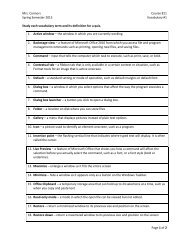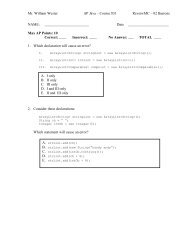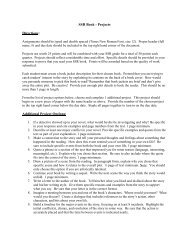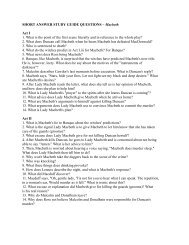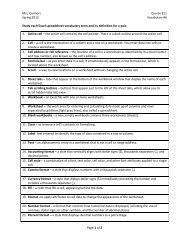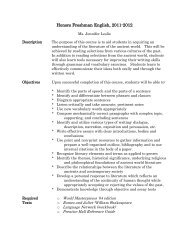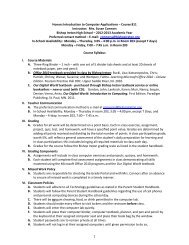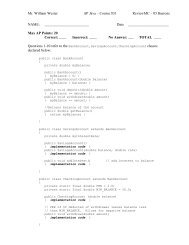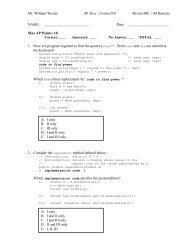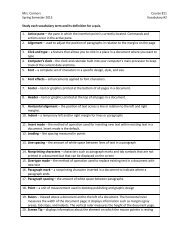Stability Across Cohorts in Divorce Risk Factors - Bishop Ireton High ...
Stability Across Cohorts in Divorce Risk Factors - Bishop Ireton High ...
Stability Across Cohorts in Divorce Risk Factors - Bishop Ireton High ...
You also want an ePaper? Increase the reach of your titles
YUMPU automatically turns print PDFs into web optimized ePapers that Google loves.
334 Demography, Volume 39-Number 2, May 2002<br />
rounds of the NSFG were nationally representative samples of women aged 15–44 who<br />
were ever married or who had a child of their own liv<strong>in</strong>g <strong>in</strong> the household. The last three<br />
rounds were nationally representative samples of all women aged 15–44. The sample sizes<br />
were 9,797 for round 1; 8,611 for round 2; 7,969 for round 3; 8,450 for round 4; and<br />
10,847 for round 5.<br />
Each round of the NSFG obta<strong>in</strong>ed retrospective <strong>in</strong>formation about the marital history<br />
of all the respondents. I used this <strong>in</strong>formation to calculate the beg<strong>in</strong>n<strong>in</strong>g and end<strong>in</strong>g dates<br />
of all first marriages. I selected all first marriages that were formed between 1950 and<br />
1984, yield<strong>in</strong>g <strong>in</strong>formation on divorces that occurred between 1950 and 1995. Over this<br />
period, there were substantial shifts <strong>in</strong> age at marriage, marital dissolution, education,<br />
out-of-wedlock childbear<strong>in</strong>g, premarital cohabitation, and divorce.<br />
Marriages formed before 1950 were excluded because they <strong>in</strong>cluded only women who<br />
married prior to age 21. I excluded marriages formed after 1984 to obta<strong>in</strong> <strong>in</strong>formation on<br />
at least 10 years of potential exposure to the risk of divorce for all marriages. Of course,<br />
earlier marriage cohorts have much longer potential marital durations. In results not reported<br />
here, however, my conclusions were not affected by the arbitrary truncation of all<br />
marriages after 10 years of exposure to the risk of divorce. 1 After I selected first marriages<br />
formed between 1950 and 1984, there were 27,296 marriages (7,611 divorces)<br />
available for analysis.<br />
Each round of the NSFG collected retrospective marital histories <strong>in</strong> a consistent fashion,<br />
limit<strong>in</strong>g the possibility that changes <strong>in</strong> the risk of marital dissolution across time are<br />
artifacts of the survey design. It is possible, though, that some historical differences <strong>in</strong><br />
marital dissolution are due to differences <strong>in</strong> samples and collection procedures. To m<strong>in</strong>imize<br />
this possibility, I constructed a set of dummy variables <strong>in</strong>dicat<strong>in</strong>g the survey round<br />
from which each respondent’s data were taken. I estimated all models with these dummy<br />
variables <strong>in</strong>cluded to provide protection aga<strong>in</strong>st survey-specific effects.<br />
Each round of the NSFG also collected different types of background <strong>in</strong>formation<br />
that can be used to predict divorce. However, there is a set of basic sociodemographic<br />
predictors available <strong>in</strong> all five rounds. These predictors are all fixed at the time of marriage<br />
and <strong>in</strong>clude wife’s age at marriage, husband’s age at marriage, education of the<br />
wife, education of the husband, premarital fertility status, parental divorce status, religion,<br />
and race. 2 From this set of variables, it is also possible to calculate estimates of the<br />
age homogamy and educational homogamy of the spouses. Although this is a somewhat<br />
limited set of predictor variables, it represents a broader array of covariates that could<br />
<strong>in</strong>teract with historical time than has hitherto been considered.<br />
To simplify the analysis, I did not consider time-vary<strong>in</strong>g <strong>in</strong>formation on marital births.<br />
Although marital fertility has been l<strong>in</strong>ked to the risk of divorce (Morgan and R<strong>in</strong>dfuss<br />
1985; South and Spitze 1986; Waite and Lillard 1991), childbear<strong>in</strong>g decisions are not<br />
fixed at the time of marriage. Because children can be born at any marital duration and<br />
their effects on marital dissolution vary accord<strong>in</strong>g to their age and number (Waite and<br />
Lillard 1991), isolat<strong>in</strong>g the effects of marital childbear<strong>in</strong>g as they vary accord<strong>in</strong>g to marital<br />
duration and historical period is not straightforward. It rema<strong>in</strong>s the task of a subsequent<br />
research project to tackle this problem.<br />
1. I truncated all marriages at 10 years’ duration by cod<strong>in</strong>g marriages of longer duration as be<strong>in</strong>g censored<br />
at that po<strong>in</strong>t. I then reestimated each of the event-history models described later, and found no substantive<br />
differences.<br />
2. In most cases, these predictor variables were measured consistently across rounds of the NSFG. However,<br />
there are a few differences <strong>in</strong> measurement that should be noted. Parental divorce status was measured at<br />
age 14 for the respondent <strong>in</strong> the first four rounds (Was the respondent not liv<strong>in</strong>g with both biological parents<br />
because of divorce?) but us<strong>in</strong>g a full parent history <strong>in</strong> round 5 (I used this parent history to code whether the<br />
respondent was not liv<strong>in</strong>g with both parents at age 14 because of divorce). Wife’s education was measured at the<br />
time of marriage <strong>in</strong> rounds 1, 2, and 4 and the highest level atta<strong>in</strong>ed <strong>in</strong> rounds 3 and 5. Husband’s education was<br />
measured at marriage <strong>in</strong> all rounds except round 3, when it was measured as the highest level obta<strong>in</strong>ed.




